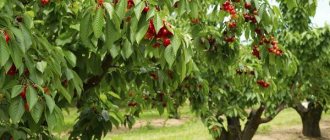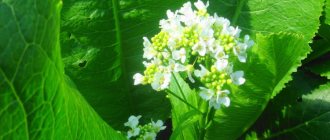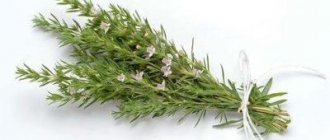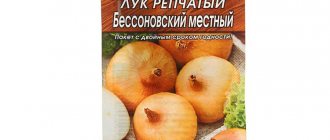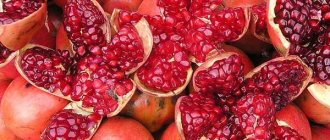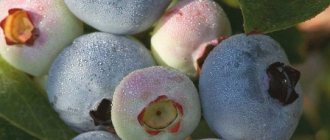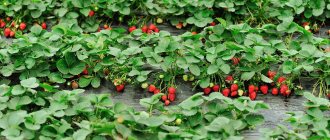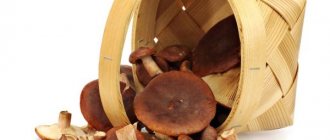History of appearance
The yellow watermelon was bred several decades ago as a result of an experiment by breeders who crossed two types of berries with each other - ordinary melons and wild ones. From the former, he inherited sweetness and juiciness, and from the latter, the color of the pulp. It is worth noting that wild watermelon itself is not eaten as it has an extremely unpleasant taste.
Suspicions that the yellow watermelon was bred through the use of GMO technologies with the introduction of the lemon or mango genome into them have been completely rejected by scientists, and the only reason for the yellow color of the hybrid pulp is the “inheritance” from the wild watermelon.
Yellow watermelons were originally widely grown in Mediterranean countries and Thailand, but today they are popular all over the world. In Russia, they grow not only in the regions of the middle zone, but also in the unfavorable climatic conditions of the Urals and Siberia, since they bear large fruits even in the absence of the bright Mediterranean sun and heat.
Yellow watermelon is also known as moon or baby watermelon. In Thailand and Spain, this berry is in greater demand than the red one, and while the Thais prefer oval varieties, the Italians prefer round ones.
Origin and where grown
There is a rumor among people that watermelons of yellow-fruited varieties appeared as a result of crossing an ordinary pink watermelon with a melon. In fact, everything is completely different. Breeders obtained the unusual golden-yellow shade of juicy pulp by crossing a cultivated red watermelon with its wild counterpart, the African one.
Yellow-fruited watermelons are grown in Egypt, Spain, Greece, Poland, the Czech Republic, Israel, the USA and Thailand, and more recently in Russia. The domestic variety of yellow watermelon Lunny is grown on plantations in the Kuban, Krasnodar Territory and Astrakhan.
Description of characteristics
A watermelon with yellow flesh resembles an ordinary berry in its external characteristics, but if you look closely, you can notice some differences. Firstly, their peel has a darker color, and secondly, it can be plain, that is, devoid of stripes. At the same time, “baby” always has light or brighter yellow flesh.
Fruits can weigh from 3 kg to 10 kg. The largest berries ripen in the hot southern climate. In the conditions of the northern regions, watermelons weighing between 3-5 kg ripen.
Energy value
The nutritional value of one slice of watermelon (about 150 g) is as follows:
- calorie content: 38 kcal;
- fiber: 1 g;
- carbohydrates: 6.2 g;
- proteins: 0.6 g;
- fats: 0.1 g.
One slice of watermelon contains 17% of the daily requirement of vitamin A, 21% of vitamin C. In addition, the berry is rich in calcium, potassium, magnesium, iron, sodium and phosphorus. Watermelon contains virtually no fat or cholesterol, so it is considered a low-calorie product and can be consumed during weight loss. The berry can also be present in the diet of people with obesity or atherosclerosis.
Some watermelons of this subspecies have the flavor of lemon, mango and pumpkin, so they are especially valued by gourmets. However, the composition of such berries remains unchanged - they contain fiber, glucose and fructose, vitamins and microelements.
Beneficial features
Watermelon with yellow flesh is valued for the following beneficial properties:
- strengthens the body's defenses, helping to resist the effects of infections and viruses, since it contains ascorbic acid;
- has a diuretic effect, effectively cleanses the gastrointestinal tract of decay products and excess fluid, normalizes the activity of the digestive system due to the content of dietary fiber;
- strengthens vision and prevents the development of eye diseases, saturating the body with vitamin A;
- improves the condition of nails, hair and bones due to calcium content;
- has a good effect on the heart and blood vessels, reducing the likelihood of developing anemia and anemia, since it saturates the body with iron, magnesium and potassium;
- stabilizes intercellular metabolism due to the content of carotenoids.
The richest composition of minerals and vitamins makes yellow watermelon the most beneficial product for the cardiovascular system, kidneys and endocrine glands.
Harm and contraindications
Despite all the benefits of yellow watermelon, it can negatively affect the body’s condition in the case of a number of contraindications. These include:
- intestinal problems;
- diabetes;
- kidney failure (watermelon increases the load on the kidneys);
- individual intolerance.
If there are no such contraindications, watermelon can be safely included in the diet.
Harm and contraindications
We recommend reading our other articles
- Peach pruning in spring
- Melon variety Altai
- Cucumber variety Gunnar F1
- Felt cherry
Eating yellow watermelons is no less beneficial than red ones, but they also have a number of contraindications.
- You should not eat too much watermelon as this can lead to intestinal problems.
- Not recommended for people with diabetes.
- May harm people with kidney failure, as it puts a lot of stress on the kidneys.
- If you are individually intolerant to the product, its consumption should be stopped.
Differences from red watermelon
Of course, the main difference between the two types of watermelons lies in the color of the pulp. The color inside the yellow watermelon is uncharacteristic for this plant, but the pulp has almost the same nutritional qualities - very juicy and with a pleasant sugary aftertaste. As for other differences, they look like this:
- the rind on watermelons with yellow flesh is thinner and drier, somewhat reminiscent of the skin on a pumpkin or melon;
- there are practically no seeds inside the yellow watermelon, and when the berry ripens, they darken, but remain thin and soft, reminiscent of the seeds of young zucchini;
- yellow watermelon contains less sugar, so it can be consumed in small quantities by diabetics, but only with the permission of a doctor;
- the pulp of a yellow watermelon has almost the same juiciness and density as the pulp of a red one, but contains less free juice (water);
- the aftertaste after yellow watermelon is longer;
- Yellow watermelons ripen faster than red ones, so they are considered early.
How yellow watermelon tastes different from red one can be found out in the following video:
How to grow yellow watermelon
Yellow watermelon is no less demanding on cultivation technology, like its other species. It requires a lot of light, dry weather, irrigation regime and fertile soil. It can be planted through seeds or seedlings. The soil should be loose and fertilized with mineral fertilizers and humus. In order to plant seedlings in May, it is necessary to sow in a greenhouse from April. Yellow watermelon can be cultivated not only in the field, but also in a greenhouse on a trellis. The plant is endowed with a powerful root system. The best region for growing watermelon is the south; in other regions the berries may be of lower quality (the fruits are smaller in size and not as sweet).
Main varieties and hybrids
Breeders offer a large selection of yellow berry varieties. About a dozen varieties were bred in the post-Soviet space alone. For example, Ukrainian breeders introduced the Kavbuz hybrid, but it was not widely used because the taste is too similar to pumpkin. What varieties and hybrids of yellow watermelons are in demand today are presented in the following table:
| Variety | Motherland | Characteristics |
| Lunar | Developed at the All-Russian Research Institute of Melon and Vegetable Growing, located in Astrakhan, by crossing the Astrakhan berry and a wild representative of the melon family. | It is an early ripening variety, the growing season of which is 70-90 days. The yield of moon watermelon is 1.6 kg per 1 sq. m. One berry can weigh 3-4 kg. It has an oval-round shape, a peel with clearly defined stripes, a bright lemon-colored pulp and a specific taste with mango notes. The variety withstands cold weather. |
| Golden Grace F1 | The variety comes from Holland and is produced by the seed company Hazera. It is popular among Russian, Ukrainian and Belarusian summer residents. | A watermelon hybrid with a growing season of 70-75 days. Suitable for growing in different types of soil. The average weight of one fruit is 6-8 kg. It has a round-oval shape, a light green crust with dark stripes and a bright yellow flesh with small, almost transparent seeds. The variety is resistant to low temperatures and lack of light. |
| Yellow dragon | Thailand is considered the birthplace of the variety. It is in this country that it is most often grown, since in this climatic zone it produces a full harvest. | The growing season of the Yellow Dragon averages 60-62 days. The weight of one fruit reaches from 4 to 6 kg. It has a round shape, but its ends are slightly elongated. The crust is thin and dark in color. The pulp is bright yellow (canary) in color and has a sweet taste reminiscent of honey. |
| Janosik | The heat-loving crop comes from Poland, which is grown in open ground and film tunnels. | It is an original mid-early variety that ripens in 75-82 days. The weight of one berry can be from 3 to 6 kg. The fruits have a round or rounded-ovoid shape, a light thin rind with inconspicuous stripes and yellow flesh with a low seed content. The variety is resistant to diseases and can be stored without loss of taste. |
| Prince Hamlet F1 | The breeders of the hybrid variety are not indicated, but the seeds are produced by producers in many countries, including Russia and the USA. | It is a mid-season hybrid, the ripening period of which is 70-80 days. Plant productivity is 4-6 kg per 1 sq. m. The average weight of one fruit is 1-2 kg. It has a round shape, a thin dark green rind, lemon-yellow seedless flesh and a sweet, rich taste. |
| Imbar F1 | A seedless hybrid, bred by Israeli selection from Hazera Genetics. | The ripening period for Imbar is 60-65 days. The variety has medium vigor and sets fruit easily in various conditions. The fruits weigh 4-6 kg, have a glossy dark green rind without stripes. The pulp of Imbar is firm and crisp, without seeds and dark yellow or orange in color. |
| Orange method | An early maturing hybrid from Russia, bred for the middle zone. | The growing season of the variety ranges from 60 to 65 days. The weight of one ripe watermelon is small - about 2-2.5 kg. The fruits have a round shape, a striped rind and orange-yellow flesh, which is distinguished by a honey flavor and increased sweetness (sugar content - 13%). |
| Yellow doll | Hybrid from the USA. Can be grown in limited space. | An early ripening variety that ripens within 70 days. The fruits grow small - up to 2.2-3 kg. They have an oval shape and a thin light green crust, which is covered with almost black stripes. The pulp has a bright lemon-yellow color, dense texture, sweet taste and honey aroma. |
| Primaorange F1 | The birthplace of the hybrid is the Czech Republic. Used for growing in open ground. | Ultra early variety - ripens within 45-50 days. The fruits have a typical round shape and weigh up to 3-4 kg. The rind is thin and green, covered with dark green stripes. The pulp is bright orange, sweet (sugar content - 11-12%) and juicy. There are a small number of seeds in the center of the fruit. |
In Russia, such varieties as Lunar, Orange Medok, Prince Hamlet and Golden Grace are popular, in the USA - Yellow Doll, in Thailand - Yellow Dragon, in Poland - Janusik, in the Czech Republic - Primaorange, and in Israel - Imbar.
Miracles of selection
Yellow watermelons appeared in the 80s. last century. If we consider what the yellow watermelon is crossed with, then this is the result of selection of an ordinary watermelon with its wild fellow colocynth. It is the latter that is responsible for why the developed variety has yellow flesh.
The selection of the new hybrid was carried out in Thailand. According to Feng Shui, yellow is the color of prosperity and abundance. Thailand and Spain are the main exporters of “sunny” berries. The fruits grown in both countries are different in type and size.
One of the most delicious hybrids was bred in 2007 by breeder from Astrakhan Sergei Sokolov. The variety is called "Lunar". It is characterized by resistance to diseases and can be grown in regions with moderate climatic conditions.
Onions - description of 33 varieties with their photos and main characteristics, ripening periods and other useful information (Video) + Reviews
Growing seedlings
You can sow watermelon seeds for seedlings at the end of March - beginning of April, so that from about mid-May you can transplant them to a permanent place - in open ground, a greenhouse or a greenhouse. In any case, to get a good harvest, you need to properly grow seedlings. We'll figure out how to do this further.
Preparation
Before you start sowing, you will need:
- Choose containers for seedlings . It is extremely capricious in transplantation, since the seedlings are stressed, and the root can suffer even if it is slightly disturbed. So that you don’t have to face any difficulties in the future, you should use ready-made containers like peat cups, disposable dishes with drainage holes or cassettes for growing seedlings. The optimal container volume is 250-300 ml, since seedlings with a clod of earth can be easily removed from it without disturbing the plant’s root system.
- Prepare the substrate . To grow seedlings, you can use a mixture that consists of equal amounts of river sand, peat and earth (humus). For every 10 kg of such substrate, you can add 200-250 kg of wood ash. In order not to prepare the composition yourself, you can purchase a mixture for growing pumpkin crops at a garden store.
- Prepare the seeds . Before planting, the seeds should be soaked in warm water (50°C) for several hours, and then thrown into a weak solution of potassium permanganate or potassium permanganate for 1-1.5 hours. After soaking, the seeds must be rinsed with clean water and dried.
Sowing
Once the seeds and substrate are ready, you can sow:
- Fill the container 2/3 with substrate.
- Water the soil with warm water.
- Stick 2 seeds into the soil, sprinkle 2 cm of peat-sand mixture and lightly moisten. If cassettes are used to grow seedlings, then one seed must be inserted into each cell filled with moist substrate. The acceptable depth for their embedding is 3-4 cm.
- Cover the container with film until the first shoots appear. Transfer it to a warm and bright place.
Care
The following activities need to be carried out:
- Watering . With the appearance of the first shoots, every other day, moderately water the seedlings along the edges of the container. At the same time, it is forbidden to pour out a large amount of water, since water hammer can cause irreparable harm to the seedlings.
- Loosening . As soon as a crust forms on the soil, it is necessary to loosen it carefully so as not to damage the root system of the plant.
- Lighting . Watermelon seedlings need long daylight hours - about 12 hours. So, in the evening, seedlings should be illuminated using lamps. In addition, artificial lighting is useful on cloudy days.
- Temperature regime . With the appearance of the first shoots, the temperature must be reduced to 18ºC within 4-5 days. Subsequently, it should be maintained at 22ºС.
- Feeding . When the third leaf appears, it is recommended to apply liquid mineral fertilizers and liquid mullein.
- Hardening . It is carried out 2-3 days before planting seedlings in open ground. It involves a gradual decrease in temperature, a reduction in the number of waterings and regular ventilation of the room. This will make the plant more resistant to low temperatures and droughts, and its roots will develop much faster than those of unhardened plants.
Hardening should be moderate, otherwise the seedlings will develop slowly, and in the worst case, will not recover at all.
Planting in open ground
Seedlings with 2-3 true leaves can be planted in open ground. As a rule, they appear on the 25th day after sowing the seeds. Planting should be done in an area that is well lit by sunlight and heated, and protected from shade on the south side. The best soil types for yellow watermelon are sandy and sandy loam.
Before planting, the soil should be loosened 2-3 times, and the last loosening should be carried out directly on the day of planting. You need to plant the earthen ball in moist, warm soil, acting as carefully as possible so as not to touch the roots and bores. The plant must be planted so deep that the root collars are completely underground, otherwise they may be damaged by winds. Seedlings need to be planted in holes, the distance between which is about 80 cm.
After planting, the seedlings need to be watered so that the soil is compacted and the roots do not get stuck in the air pockets formed when planting the seedlings. In addition, this technique will contribute to the rapid development of the root system of watermelons.
Within a week, the yellow watermelon seedlings will take root and produce new leaves.
Caring for yellow watermelons
To reap a full harvest, you need to provide proper care for watermelon seedlings. First of all, after planting for several nights, watermelons should be covered at night if large temperature changes are observed. In addition, care involves the following activities:
- Watering . Initially, the plant needs to be watered once every 2 days, and then 1-2 times a week. In order for watermelons to fill quickly and not experience a lack of moisture, you should water abundantly, literally pouring water over the melon (30-35 liters per 1 sq. m).
- Top dressing. The planted seedlings are fed with the usual fertilizers for pumpkin plants. 10 days after planting per 1 sq. m of plot, 10-15 kg of humus and 25 g of phosphorus-potassium fertilizer should be added. There is another fertilizing option: after 10 days, fertilize the soil with ammonium nitrate, after 1-2 days with liquid mullein, and after 2-3 weeks with superphosphate. Apply phosphorus-potassium substances only when the ovaries appear. Fertilizing will help increase the yield of watermelon, but it should be noted that yellow varieties do not tolerate excess nitrogen fertilizers.
Applying large amounts of manure will prolong the growing season, make the plant more vulnerable to various diseases and produce weak fruits with unsweetened pulp.
- Loosening . Before flowering begins, you should loosen the soil several times in the rows and between the rows.
- Pinching . In order for the fruits to grow as large as possible, you should leave the first 2-3 fruits, and after them, after 3 leaves, pinch the whip.
- Protection from diseases . If preventive measures are ignored, the watermelon may be affected by diseases, which will lead to the formation of low-quality fruits with poor pulp. So, from the beginning of flowering in the period between rains, the plant should be treated against diseases using fungicides, for example, Ridomil Gold and Quadris.
Unfortunately, when growing yellow watermelons, melon growers sometimes have to face a problem when the seedlings are affected by the following diseases and pests:
- Downy mildew . An infection that causes the leaves to dry out so that at the end only petioles and veins remain. In order to avoid encountering such a disease, it is necessary to disinfect the seed before planting, and then treat the planting itself with Oxychom.
- Anthracnose . Unlike the previous infection, anthracnose affects not just the leaves, but the entire plant. When it goes to the root, the watermelon dies. To combat infection, the planting can be treated with a suspension of bleach or Bordeaux mixture.
- Melon black aphid . This is a pest that sucks the life juices out of the plant. If it infects a watermelon, then insecticides can be used against it, for example, Inta-Vir or Aktara.
Proper care of the plant will allow you to get a quick harvest of yellow watermelons. Ripe fruits can not only be eaten fresh, but also canned and salted.
Harvesting
Around the end of July, the fruits will begin to gain weight, so you can begin preliminary preparations for harvesting them:
- place plywood under each fruit to prevent rotting;
- reduce watering to give maximum sweetness to the pulp.
When it is noticed that the fruits have stopped gaining weight, you should wait 2 weeks and only then begin harvesting. You can pay attention to other signs of watermelon ripeness:
- the peel is white or yellowish in the place where the fruit came into contact with the ground;
- shiny rind color;
- dull sound when tapping the berry;
- dry tail.
When harvesting, one should not neglect the signs of ripeness, since after cutting the watermelon does not ripen.
If the fruits are already ripe, they should be cut from the stem and not torn off, and you need to act carefully so as not to damage the rind. The collected fruits should be placed bottom down and kept at a temperature of 10-15°C. Air humidity should be high - 85-90%.
The yellow watermelon was first obtained by Mediterranean breeders by crossing a wild berry with an ordinary one. Today, such varieties are popular not only in the southern regions, but also in mid-latitudes. So, every melon grower can grow an original watermelon in his garden with a honey flavor and yellow flesh, which can be used to decorate any summer dessert.
0
0
Copy link
Signs of nitrate watermelon
It is not recommended to choose large fruits . This means that the plant is oversaturated with fertilizers. If in doubt, you should ask the seller for a conclusion from the SES (sanitary and epidemiological service). Products offered for sale must be tested.
After purchasing, carefully examine the pulp. If it is whitish in color or has yellow or white streaks (less often, light spots), as well as cavities, then the nitrite content in the berry is definitely exceeded. Another sign of nitrate is pale and small bones. In ripe berries they should be brown.
If the inside of the watermelon is yellowish, it may also mean that it is simply not ripe . In this case, you should not eat it, since unripe fruits can cause an eating disorder. There is no point in leaving such a watermelon in the hope that it will “arrive.” These berries can only ripen on melon fields.
